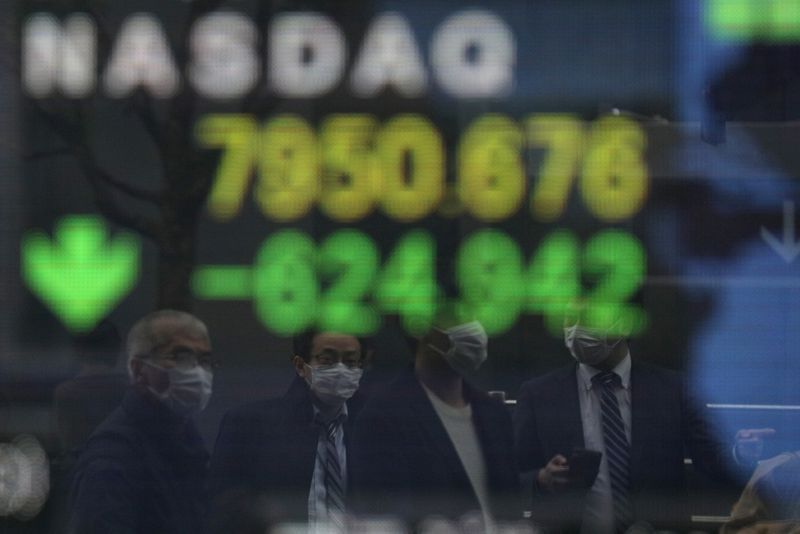
FILE PHOTO: People wearing protective face masks, following an outbreak of the coronavirus disease (COVID-19), are reflected in a screen displaying NASDAQ movements outside a brokerage in Tokyo, Japan, March 10, 2020. REUTERS/Stoyan Nenov
March 12, 2020
By Hideyuki Sano
TOKYO (Reuters) – Global shares were set for a rocky ride on Thursday as investors tally the economic damage of coronavirus, a day after the U.S. Dow Jones industrials entered bear market territory and world health officials declared the virus a pandemic.
Markets desperate for government action to offset the impacts of the global outbreak will look to an address by U.S. President Donald Trump scheduled for 9 p.m. EDT (0100 GMT).
“Markets are crying out for a co-ordinated response to COVID-19 headwinds and a lack of concrete U.S. policy action is rattling markets,” Tapas Strickland, director of economics at National Australia Bank in Sydney said in a report.
MSCI’s broadest index of Asia-Pacific shares outside Japan <.MIAPJ0000PUS> dropped 0.27% in early trade while Nikkei futures <NIYcm1> suggest a 0.5% fall in Japanese shares <.N225>. Australia’s benchmark <.AXJO> was down 2.8%.
U.S. S&P500 futures <ESc1> recouped a small part of big losses the previous day, gaining 0.4% in early Thursday trade.
On Wednesday, the S&P 500 <.SPX> lost 4.89% while the Dow Jones Industrial Average <.DJI> fell 5.86% to extend its fall from a record peak hit a month ago to more than 20%.
European shares closed at a 14-month low even after Britain announced a $39 billion war chest to soften the impact of the coronavirus.
The FTSE 100 <.FTSE> closed down 1.6%, extending a slump into a fifth day, as investors doubted whether the stimulus and the rate cut would be enough to counter the shock from the coronavirus outbreak.
Some safe-haven assets gave up recent gains, a move that some market players suspect is a desperate bout of profit-taking to make up for losses made elsewhere.
Gold <XAU=> dipped to $1,640.7 per ounce from Monday’s high above $1,700.
The 10-year U.S. Treasuries yield rose back to 0.878% <US10YT=RR>, more than 50 basis points above a record low of 0.318% touched on Monday. Some analysts say the rise could reflect worries about an increase in government spending for stimulus.
The two-year yield also jumped back to 0.525% compared to Monday’s low of 0.251%.
But rising yields by no means suggest any easing in expectations of Fed rate cuts.
Fed fund rate futures <0#FF:> are pricing in a rate cut of at least 0.75 percentage points and about a 30% chance of a 1.0 percentage point cut at a policy review on March 17-18.
Oil prices were wobbly, having fallen about 4% on Wednesday, on renewed weakness in the stock market and as Saudi Arabia and the United Arab Emirates announced plans to escalate the burgeoning price war.
U.S. West Texas Intermediate (WTI) crude <CLc1> last traded up slightly at $33.32 per barrel.
In the currency market, the dollar slid against the safe-haven yen and the Swiss franc.
The U.S. currency stood at 104.63 yen and 0.9392 franc <CHF=>.
(This story corrects day in first paragraph)
(Reporting by Hideyuki Sano; editing by Richard Pullin)
